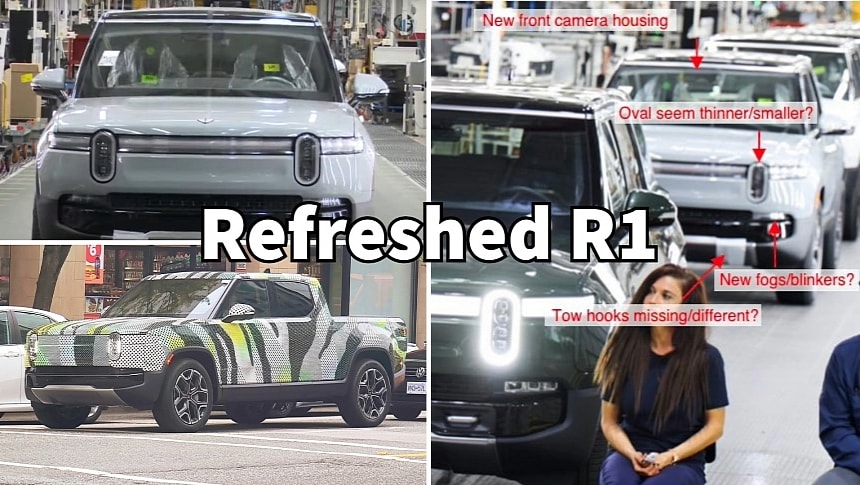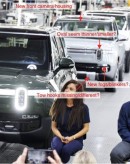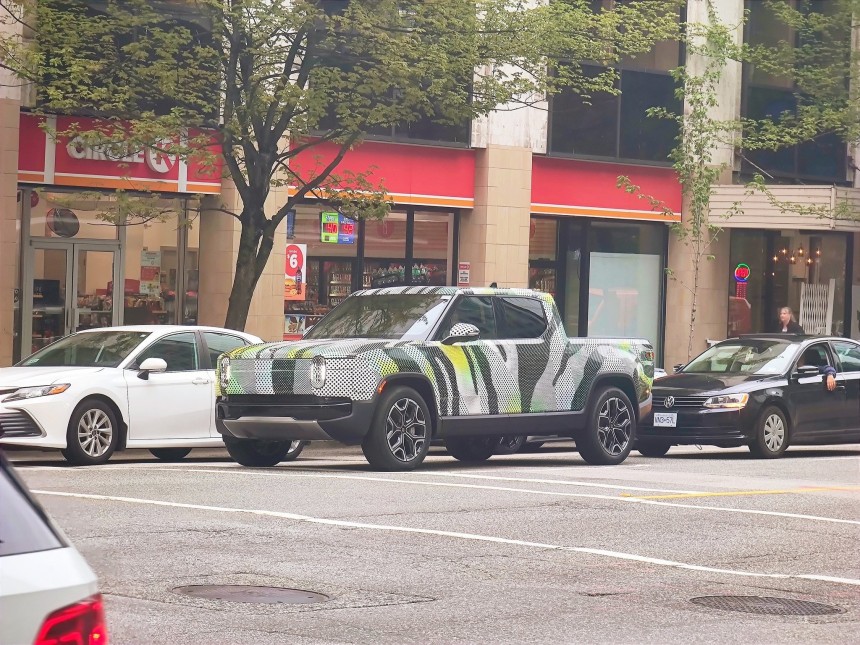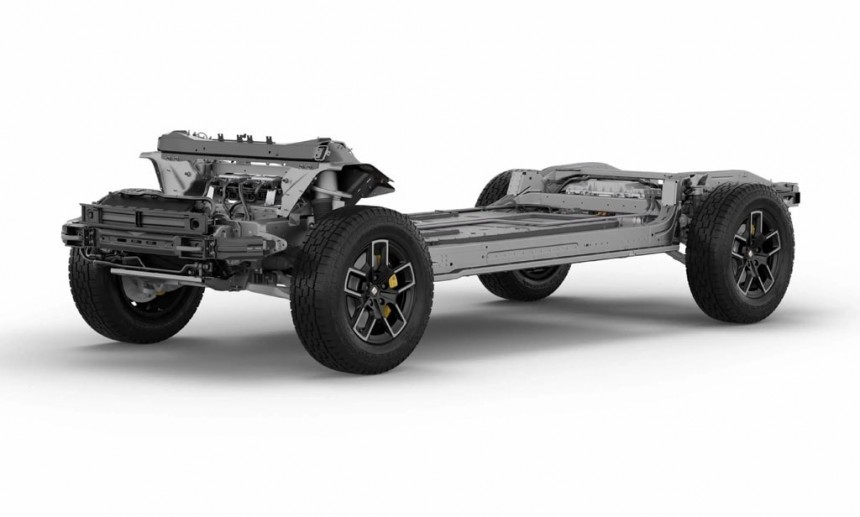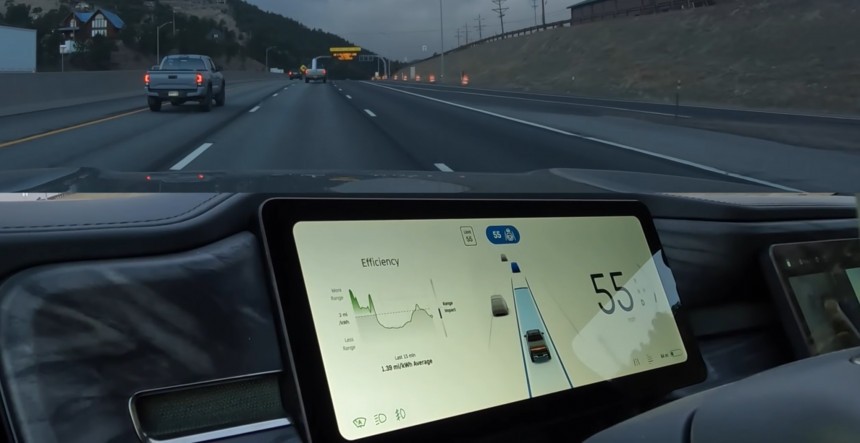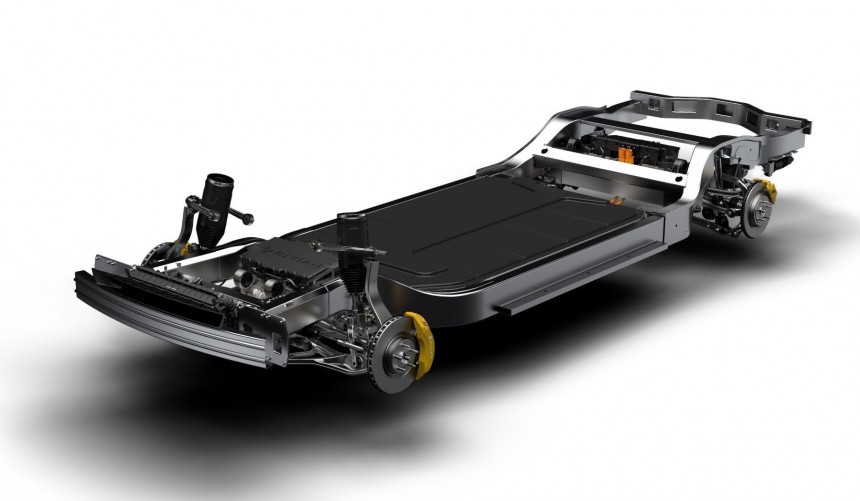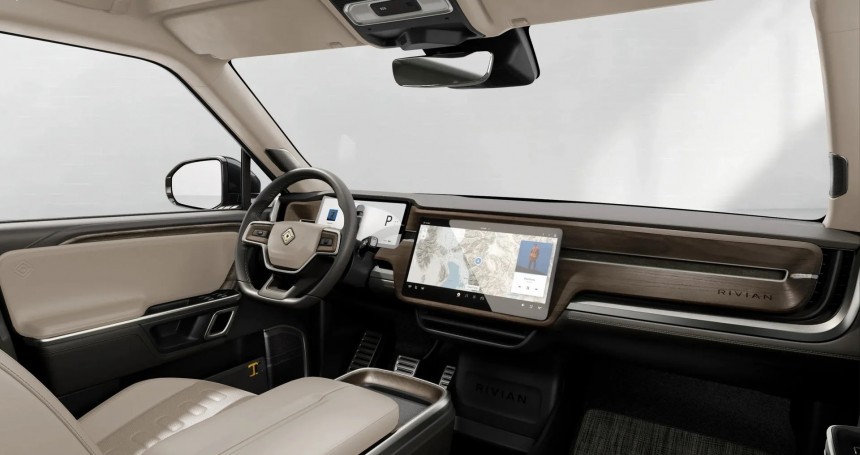Rivian is very close to opening the order books for the refreshed R1S and R1T. The trial production has already begun at its factory in Normal, Illinois, as revealed during a recent event. The updated R1 vehicles will look mostly the same but vastly different from the current models. Here's everything you should know about the refreshed R1 lineup.
Rivian has been talking about the refreshed R1 lineup for more than a year when the new models were still on the drawing boards. Earlier this year, the Rivian plant in Normal, Illinois, paused production to start upgrading the equipment necessary to build the new R1S and R1T EVs. The upgrade works appear to have been completed, so the official announcement about the refreshed models should not be far.
Some believe this could happen as soon as May 7, during the first quarter earnings call. However, this could be too soon unless Rivian starts reservations now and delivers the vehicles later. However, an announcement without an immediate delivery start will affect current model sales due to the Osborne effect. Rivian has a second chance to make the announcement on June 27, during the Investor Day.
Based on pictures shared recently by JB Pritzker, the Governor of Illinois, the first refreshed R1S and R1T vehicles have already started rolling off the production line. This means the equipment calibration has ended, and trial production is underway. The pictures were taken during an event where Rivian announced a $1.5 billion investment at Normal in exchange for $827 million in state incentives over 30 years. The package gives Rivian a shot in the arm at a crucial moment.
The Rivian R1T started deliveries in October 2021, and the R1S followed almost a year later. Based on industry standards, the two electric vehicles are not necessarily old, although three years is a normal refresh cycle. This is why the refreshed models are not so much about offering a new look to keep them relevant. Obviously, Rivian doesn't think the R1 models need a redesign, considering that R2 looks almost identical. Instead, the EV startup seized the moment to optimize R1S and R1T production to cut costs and boost efficiency.
This is why the refreshed models have been given a minimal design makeover, and people will scratch their heads trying to figure out if they see the old or the updated model. This is probably good for existing owners, as the pre-refresh models will still remain relevant. The bonus is that they will hold value better, being not much different from the new models.
Rivian CEO RJ Scaringe recently promised that about 80% of the new features launched with the refreshed R1 lineup will be backported to the existing vehicles. The rest are hardware-dependent, and offering them won't be possible unless a hardware upgrade is also possible. Tesla showed this is possible by providing infotainment and Autopilot computer upgrades to its older vehicles at a reasonable price.
The new R1 vehicles will feature many upgrades under the hood, mostly to make them cheaper and faster to manufacture. Rivian focuses on cutting costs and becoming profitable, not bringing new features, although these will still be offered. Here's everything we've learned about the refreshed R1T and R1S models.
One detail that intrigued many people was the tow hooks. They were present on some of the camoed prototypes but not on the vehicles inside the factory. This suggests that Rivian might make them optional or removable, something we've already seen with the Tesla Cybertruck. This makes sense, considering that tow hooks are rarely needed. They look cool but probably affect aerodynamics to some extent.
Rivian also offered small tweaks to the headlights, which are now a tad smaller, and the fog lights, which look different. The changes to the front grille are minimal. The side mirror design appears to have also been altered, although we need better pictures to conclude. The most important changes (although even harder to notice) are those aimed at improving aerodynamics.
Expect other small changes, including a smoked light bar and piano black lower bumper. New wheel designs and, undoubtedly, new color options will also be on the list of updates. Rumors indicate that Rivian might finally offer the long-promised Evergreen and Slate colors RJ Scaringe revealed in September 2023 during an "Ask Rivian" segment.
Although nobody saw the interior of the refreshed R1 models, some say that Rivian will phase out the Forest Edge option. Undoubtedly, it will introduce new combinations unless it cuts costs by restricting the number of available options. Recent information shows that Rivian will finally offer a functional wireless charge pad, while the user interface will adopt the colorful theme seen on the R2/R3 vehicles.
The new equipment will also allow Rivian to make the necessary changes to the R1 architecture. We've already seen the EV startup replacing welded parts with die-cast equivalents. In the future, Rivian will expand the use of castings in various sections of the R1 structures. The purpose will be to replace large welded sections with megacastings, similar to what Tesla does for the Model Y and the Cybertruck.
Alongside the megacastings, Rivian is rumored to adopt a structural battery pack in the updated R1T and R1S vehicles. The information was confirmed last December by Rivian's CFO Claire McDonough, who revealed that the new packs will save the company "thousands of dollars per vehicle." Claire said the new batteries will have a "simplified battery pack and module structure" and be lighter and easier to build "within the vehicles."
The powertrain will finally see the phase-out of the Bosch drive units that equipped the Quad-Motor R1S and R1T. Rivian's Enduro motors will take over from here and become more efficient and powerful. The Enduro drive units have been instrumental in improving the cost structure for the R1 lineup. Bosch units are still in the Quad-Motor R1 only because Rivian could not produce enough Enduros. Things will change with the refresh, with the Enduro motors used exclusively.
A significant change brought by the refreshed R1 architecture will reduce the complexity of the network architecture that connects the different ECUs and electronic components in a Rivian vehicle. Rivian announced last year that the change will cut the number of ECUs by 60% and the wiring harness by 25%. This will bring significant benefits in efficiency and costs.
In a recent interview, Rivian's software chief, Wassym Bensaid, confirmed that the refreshed R1 vehicles will sport upgraded computing hardware and a new sensor suite. This will support new automated driving features, including a Summon function. Bensaid also discussed a revamped Driver+ package introducing a subscription model for the most advanced functions. It will come later this year, alongside a Connectivity subscription.
This new set of features and the subscriptions sound a lot like Tesla's FSD/Summon and their corresponding subscriptions, which makes you wonder. Elon Musk revealed that Tesla is in talks with a major carmaker to license Full Self-Driving, although I wouldn't consider Rivian "a major carmaker." However, I wouldn't rule out a closer partnership between Tesla and Rivian in this area. We'll soon find out whether this is happening or it's just wishful thinking.
Rivian also confirmed improving the smartphone integration and plans to offer an "Apple Watch as a Key" feature. Better Android support is also in the works, although Wassym said this is more difficult because of the fragmented nature of the Android ecosystem. Video streaming, a feature rumored before, will land this summer. The videos will stream in high definition with surround sound.
Even though LFP cells have lower energy density, they bring important advantages beyond being more affordable. For Rivian owners, the most significant will be the possibility of charging them to 100% without affecting battery life. Depending on the capacity, this partly compensates for the lower energy density, as you can access more of the nominal capacity in everyday driving without worrying about degradation.
The refreshed R1 lineup will not only feature new battery pack options but also battery/trim combinations. Currently, the Quad-Motor R1S and R1T cannot be ordered with anything other than the Large pack, but the Rivian will correct this with the refreshed models. By this, I mean offering the top-of-the-line Rivian models with the biggest battery available, the Max Pack.
About the configuration of this top-of-the-line Rivian, I have seen contradictory information. Some say that Rivian will still keep Quad-Motor models in its lineup, although they will use Enduro motors instead of those supplied by Bosch. Others, on the other hand, claim the Quad-Motor configurations will disappear, and Rivian will use a Tri-Motor option instead.
I must admit I am in the latter camp, simply because Rivian is after every possible penny it can save, and a Quad-Motor variant will not offer any advantages over the Tri-Motor option. Rivian is currently the only carmaker that sells a quad-motor EV, and people have noticed that dual-motor R1 EVs are better in some extreme off-road scenarios than quad-motor variants.
This is not impossible in a tri-motor configuration, considering that a dual-motor R1 develops 665 horsepower or about 333 horsepower per motor. As I said above, whether the Ascent trim will have three or four electric motors is unclear, although the former seems more likely.
Based on the Rivian VIN decoder, Ascent is not the only new trim Rivian is preparing for the refreshed R1 models. Two new variants, Premium and Entry, will also be available alongside the current Adventure pack. The Premium trim will offer more luxury equipment, focusing on comfort and convenience rather than off-road adventures.
The Entry trim, on the other hand, will be more than just a more affordable variant of the R1 models. Although it's not certain, it may only be offered on the R1T pickup truck. Many likened it to the Work Truck versions of the Chevrolet Silverado EV or the Pro variant of the Ford F-150 Lightning. This means it will be a stripped-down truck primarily destined for fleets.
Most probably, Rivian will offer the R1T Entry with an LFP battery pack, no air suspension, and no luxury features people have come to appreciate. This means a textile interior, no air compressor in the bed, and fewer practical features like the flashlight inside the door. The price will reflect the practical vocation, with some thinking that Rivian might push Entry models well under $60,000.
Some believe this could happen as soon as May 7, during the first quarter earnings call. However, this could be too soon unless Rivian starts reservations now and delivers the vehicles later. However, an announcement without an immediate delivery start will affect current model sales due to the Osborne effect. Rivian has a second chance to make the announcement on June 27, during the Investor Day.
Based on pictures shared recently by JB Pritzker, the Governor of Illinois, the first refreshed R1S and R1T vehicles have already started rolling off the production line. This means the equipment calibration has ended, and trial production is underway. The pictures were taken during an event where Rivian announced a $1.5 billion investment at Normal in exchange for $827 million in state incentives over 30 years. The package gives Rivian a shot in the arm at a crucial moment.
The Rivian R1T started deliveries in October 2021, and the R1S followed almost a year later. Based on industry standards, the two electric vehicles are not necessarily old, although three years is a normal refresh cycle. This is why the refreshed models are not so much about offering a new look to keep them relevant. Obviously, Rivian doesn't think the R1 models need a redesign, considering that R2 looks almost identical. Instead, the EV startup seized the moment to optimize R1S and R1T production to cut costs and boost efficiency.
Rivian CEO RJ Scaringe recently promised that about 80% of the new features launched with the refreshed R1 lineup will be backported to the existing vehicles. The rest are hardware-dependent, and offering them won't be possible unless a hardware upgrade is also possible. Tesla showed this is possible by providing infotainment and Autopilot computer upgrades to its older vehicles at a reasonable price.
The new R1 vehicles will feature many upgrades under the hood, mostly to make them cheaper and faster to manufacture. Rivian focuses on cutting costs and becoming profitable, not bringing new features, although these will still be offered. Here's everything we've learned about the refreshed R1T and R1S models.
Subtle design changes, new color options
We've already seen prototypes of the refreshed lineup testing, which offered us some hints of what to expect regarding optical changes. The pictures from the Normal investment announcement offer an even better look at the new EVs since they are not camouflaged. Remember that this will require a spot-the-difference champion to identify the latest model.One detail that intrigued many people was the tow hooks. They were present on some of the camoed prototypes but not on the vehicles inside the factory. This suggests that Rivian might make them optional or removable, something we've already seen with the Tesla Cybertruck. This makes sense, considering that tow hooks are rarely needed. They look cool but probably affect aerodynamics to some extent.
Expect other small changes, including a smoked light bar and piano black lower bumper. New wheel designs and, undoubtedly, new color options will also be on the list of updates. Rumors indicate that Rivian might finally offer the long-promised Evergreen and Slate colors RJ Scaringe revealed in September 2023 during an "Ask Rivian" segment.
Although nobody saw the interior of the refreshed R1 models, some say that Rivian will phase out the Forest Edge option. Undoubtedly, it will introduce new combinations unless it cuts costs by restricting the number of available options. Recent information shows that Rivian will finally offer a functional wireless charge pad, while the user interface will adopt the colorful theme seen on the R2/R3 vehicles.
Architectural improvements and manufacturing optimizations
The most important changes with the R1 refresh are under the hood and on the production line. The latter has been optimized to increase the production capacity from 150,000 to 215,000 vehicles per year. However, Rivian doesn't need all that capacity immediately, as it offered guidance for less than 60,000 units in 2024. This takes into account the production halt for equipment upgrades at the factory.The new equipment will also allow Rivian to make the necessary changes to the R1 architecture. We've already seen the EV startup replacing welded parts with die-cast equivalents. In the future, Rivian will expand the use of castings in various sections of the R1 structures. The purpose will be to replace large welded sections with megacastings, similar to what Tesla does for the Model Y and the Cybertruck.
The powertrain will finally see the phase-out of the Bosch drive units that equipped the Quad-Motor R1S and R1T. Rivian's Enduro motors will take over from here and become more efficient and powerful. The Enduro drive units have been instrumental in improving the cost structure for the R1 lineup. Bosch units are still in the Quad-Motor R1 only because Rivian could not produce enough Enduros. Things will change with the refresh, with the Enduro motors used exclusively.
A significant change brought by the refreshed R1 architecture will reduce the complexity of the network architecture that connects the different ECUs and electronic components in a Rivian vehicle. Rivian announced last year that the change will cut the number of ECUs by 60% and the wiring harness by 25%. This will bring significant benefits in efficiency and costs.
Upgraded hardware will allow new driver assistance systems
Rivian is expected to vastly improve its software game with more advanced driver assistance systems. To do that, the EV startup will have to introduce better sensors and more computing power to the refreshed R1 lineup. The former is hinted at by the new front camera housing behind the rearview mirror we saw in the recent pictures. This suggests a new sensor package is installed on the refreshed models. Hopefully, they will include higher-resolution cameras because the existing ones are almost unusable for surveillance purposes.In a recent interview, Rivian's software chief, Wassym Bensaid, confirmed that the refreshed R1 vehicles will sport upgraded computing hardware and a new sensor suite. This will support new automated driving features, including a Summon function. Bensaid also discussed a revamped Driver+ package introducing a subscription model for the most advanced functions. It will come later this year, alongside a Connectivity subscription.
Rivian also confirmed improving the smartphone integration and plans to offer an "Apple Watch as a Key" feature. Better Android support is also in the works, although Wassym said this is more difficult because of the fragmented nature of the Android ecosystem. Video streaming, a feature rumored before, will land this summer. The videos will stream in high definition with surround sound.
New motor and battery configurations
Rivian already expanded the battery options for the current R1 lineup, but things will only improve with the upcoming refresh. The EV startup is rumored to adopt lithium-iron-phosphate (LFP) cells across the lineup, presumably for the base variants. Currently, Rivian offers Standard and Standard+ packs, although they do not use LFP cells. However, Rivian has already introduced LFP cells for its commercial vans (EDV/RCV).Even though LFP cells have lower energy density, they bring important advantages beyond being more affordable. For Rivian owners, the most significant will be the possibility of charging them to 100% without affecting battery life. Depending on the capacity, this partly compensates for the lower energy density, as you can access more of the nominal capacity in everyday driving without worrying about degradation.
The refreshed R1 lineup will not only feature new battery pack options but also battery/trim combinations. Currently, the Quad-Motor R1S and R1T cannot be ordered with anything other than the Large pack, but the Rivian will correct this with the refreshed models. By this, I mean offering the top-of-the-line Rivian models with the biggest battery available, the Max Pack.
I must admit I am in the latter camp, simply because Rivian is after every possible penny it can save, and a Quad-Motor variant will not offer any advantages over the Tri-Motor option. Rivian is currently the only carmaker that sells a quad-motor EV, and people have noticed that dual-motor R1 EVs are better in some extreme off-road scenarios than quad-motor variants.
New trims above and below the current range
Rumors about performance variants of the R1 models have been floating around since last year. There's also a name, Ascent, which was recently confirmed in new rumors. The Ascent trims will offer more power than the current Quad-Motor models, possibly close to 1,000 horsepower.This is not impossible in a tri-motor configuration, considering that a dual-motor R1 develops 665 horsepower or about 333 horsepower per motor. As I said above, whether the Ascent trim will have three or four electric motors is unclear, although the former seems more likely.
The Entry trim, on the other hand, will be more than just a more affordable variant of the R1 models. Although it's not certain, it may only be offered on the R1T pickup truck. Many likened it to the Work Truck versions of the Chevrolet Silverado EV or the Pro variant of the Ford F-150 Lightning. This means it will be a stripped-down truck primarily destined for fleets.
Most probably, Rivian will offer the R1T Entry with an LFP battery pack, no air suspension, and no luxury features people have come to appreciate. This means a textile interior, no air compressor in the bed, and fewer practical features like the flashlight inside the door. The price will reflect the practical vocation, with some thinking that Rivian might push Entry models well under $60,000.
